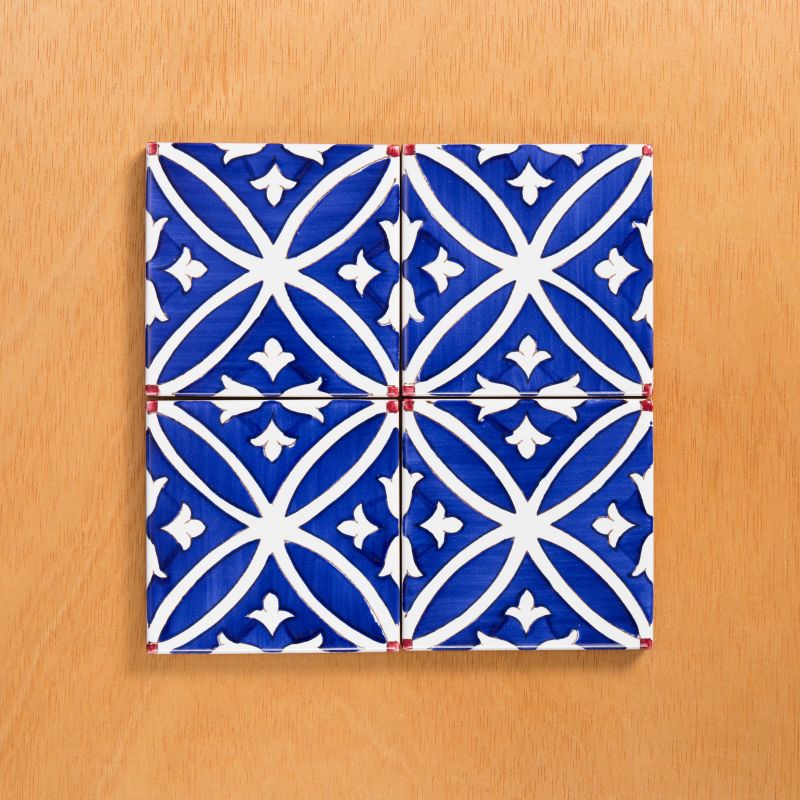DE MAIO DECORATED TILE
CERAMICA FRANCESCO DE MAIO, VIETRI SUL MARE, SALERNO, SINCE 1963
The history of Vietri ceramics is an extraordinary unicum, the result of travels and exchanges among Mediterranean countries, artistic contaminations and families of potters-keepers of tradition.
We are in the 15th century, when the town begins to specialize in the production of houseware and objects of common use, intended to supply the needs of everyday life.
At that time, there were three families active in the ceramic sector: among these the Cassetta stand out, as evidenced by a document dated 1494 which reports the sale of “fifty lancelle (jars) for storing oil” made by Matteo Cassetta.
The Cassetta family is famous for making housewares. A more refined production, decorated by using peacock feathers, appeared around the middle of the 1500s.
All the local history is intertwined with that of the family and the 17th century consecrates the fame of the Vietri artisans. In this period the demand for artifacts is so high that the laboratories, unable to meet the demand, begin to hire staff from other regions, mainly from Abruzzo.
Since then, Vietri has become the place-to-be for all those who deal with ceramics. Its wonderful decorations, the result of intertwining with the East, Africa and the Spanish culture that is active in Naples, lead to the creation of a kaleidoscope of motifs: the large flowers of Neapolitan origin mix with stylized designs, essential geometries, squares, rhombuses, but also exotic scenes, elements of Greek mythology, palm trees, camels and hunting scenes.
At the end of the 1700s, with the opening of the Royal Fabric of Capodimonte, the town underwent a drastic change: the competition from Capodimonte interrupted the production of home objects, while stimulating the birth of a new type of production: hand-decorated tiles (so-called riggiole), destined for worldwide success.
During the 19th century, Vietri enters the route of the grand tour: writers and artists celebrate its beauty, giving life to a refined and cosmopolitan debate on aestethics.
In this stimulating context, in 1894, Giuseppe Cassetta was born: at a very young age, he began as an apprentice for his uncle Giovanni Tajani, owner of the Tajani Factory, famous for having created the polychrome dome of the Cathedral of Vietri.
In 1927, Cassetta moved to I.C.S., founded by the Polish artist Max Melamerson, and here he worked alongside the German artists gathered by Melamerson and with other big names, such as Giovannino Carrano, the Procida brothers, Giovanni Gamboni. In 1944 he opened his factory, Ceramica Artistica Cassetta, and met Gio Ponti who commissioned him to make some of his drawings. Thus, in 1959, we arrive at the marriage between Vincenza Cassetta, daughter of Giovanni, and Francesco de Maio, heir to an ancient family of terracotta craftsmen in the Ogliara quarries. The union between the two families led to the birth of the first of their companies in 1963: Ceramica Francesco De Maio.
Today the company, led by Patrizia and Francesco de Maio, continues to innovate, preserving and passing on the unique heritage of Vietri ceramics.
The catalogue, astonishing for its richness, is a tribute to the wonders of the place. Alongside the traditional motifs, the inspiration coming from the landscape stand out: the secret gardens, the paths overlooking the sea, the light, the flowers, the luxuriant nature, enter the visual universe of De Maio, who transform them into decorations with bright colors. With the same will that led Gio Ponti, enchanted by the blue sea of the coast, to create the famous series of 33 decorations for Hotel Parco dei Principi in Sorrento: a line that is now reproduced exclusively by the company to celebrate the unique relation among design, art and history of our Country.
